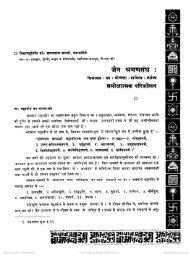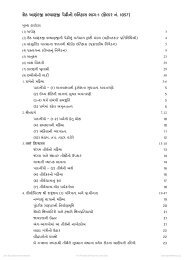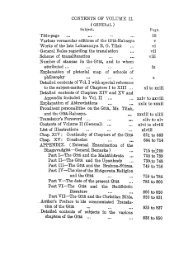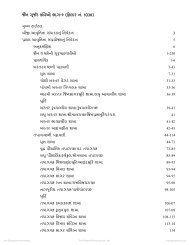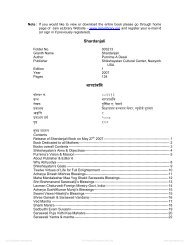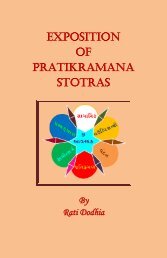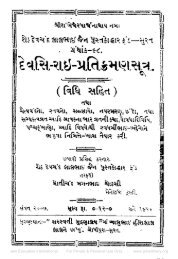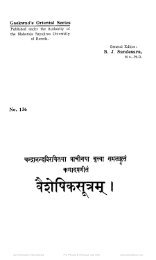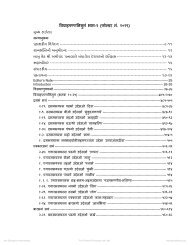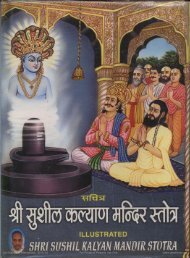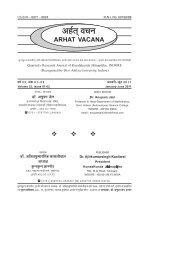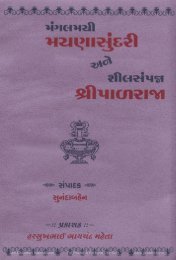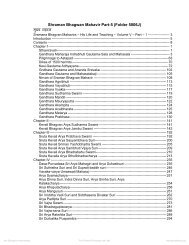Chapter - 08 Bon Po Religion - Jain Library
Chapter - 08 Bon Po Religion - Jain Library
Chapter - 08 Bon Po Religion - Jain Library
You also want an ePaper? Increase the reach of your titles
YUMPU automatically turns print PDFs into web optimized ePapers that Google loves.
Shri Ashtapad Maha Tirth - II<br />
to the self”. This approach is governed by 19 th century romantic approach to nature. According<br />
Edward Caird - “In the development of religion we look out before we look in, and we look<br />
in before we look up.”<br />
In the first stage we perceive the external world, then we look inward and in the last stage we<br />
look upward. First we see God in nature, then we see God within us and then we see God in<br />
one’s own consciousness.<br />
However, this is not the correct approach to understand and it does not reflect the real nature<br />
of “Indo-Tibetan” religion. The approach of “Indo-Tibetan” religion is from inner to outer –<br />
from internal to external. Truth first dawns in our own inner recesses and what is external is<br />
nothing but an extension of it.<br />
The voyage from the inner world to the outer world is nothing but a cognitive extension of<br />
consciousness. It is the nature of human knowledge that it is self – challenging – it is selfreflexive.<br />
Self-reflexivity is the inbuilt mechanism of human knowledge. That is the reason<br />
why men can dethrone the pressure of one’s own tradition. Man can abate one’s own tradition<br />
and can bring new cognitive revolution. This cognitive revolution will bring an existential<br />
change. It would be a qualitative change in consciousness. Our interpretation of the world<br />
would change. This is the real nature of ‘Indo-Tibetan’ religion.<br />
With this approach <strong>Bon</strong> and <strong>Jain</strong> religion must be studied.<br />
1. Commonness of the meaning of <strong>Bon</strong> and <strong>Jain</strong><br />
The meaning of ‘<strong>Bon</strong>’ is to invoke or to seed.<br />
To invoke the Truth, a pure state of consciousness must be acquired by one’s own<br />
pursuit. Seeds of permanence are to be sprouted by an individual. To live and invoke<br />
infinity within the finite is the essence of the <strong>Bon</strong> experience.<br />
The meaning of Jina is to conquer. Jina is a conqueror of indiscrimination – love and<br />
hate and desire. One who is dispassionate and detached is Jina. One who lives in the<br />
abode of eternity is ‘Jina’. Thus the meaning of ‘<strong>Bon</strong>’ and ‘Jina’ both are almost similar.<br />
2. The ultimate state of being in ‘<strong>Bon</strong>’ and ‘<strong>Jain</strong>’ religion are very close.<br />
The ultimate state is <strong>Bon</strong>ku according to <strong>Bon</strong> religion. <strong>Bon</strong>ku is a state of existence in<br />
which animalism has been completely demolished. Hence, <strong>Bon</strong>ku is a pure state of<br />
consciousness which is beyond casualty. It has an untainted existence, where living<br />
in a sensual world is not hampered by it and where knowledge is pure and direct.<br />
The philosophy of <strong>Bon</strong> is the realization of the pure self.<br />
According to <strong>Jain</strong>ism complete annihilation of love and hatred brings ‘Vitragata’ – selfpurification.<br />
It is a state of harmony. They attain the highest state of being which is<br />
known as ‘Parmeshthi’ meaning supreme state. It is the highest state of consciousness<br />
which is known as the state of Siddhas.<br />
Thus the ultimate state of <strong>Bon</strong> and <strong>Jain</strong>ism are almost similar<br />
This state of consciousness can be achieved through the process of cognitive transfer.<br />
<strong>Bon</strong> and <strong>Jain</strong> <strong>Religion</strong> - A comparative study<br />
416



